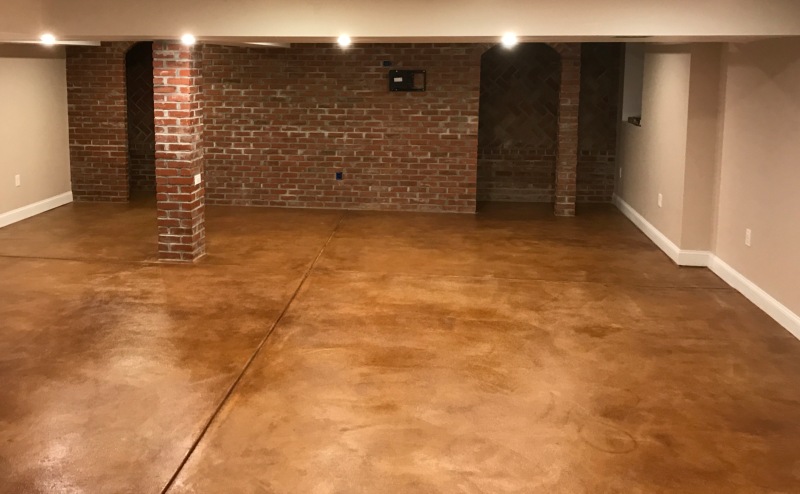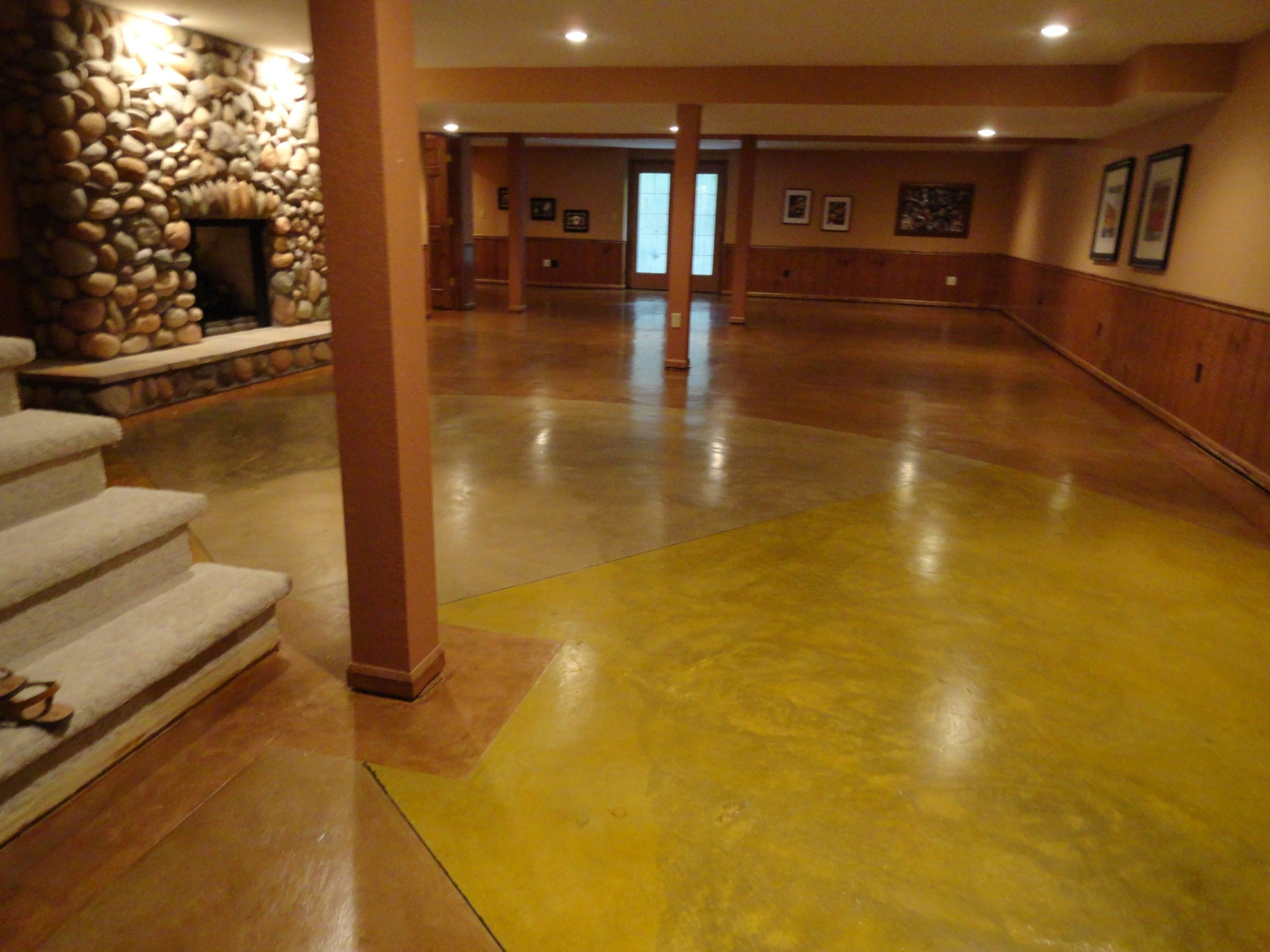Everything About Stained Concrete: A Comprehensive Guide to Its Benefits and Applications
Stained concrete has emerged as a prominent choice for both property and industrial rooms. Its ability to combine visual charm with usefulness makes it an appealing alternative. Numerous discoloration methods provide a series of shades and coatings, allowing for customization. The advantages expand past look. Recognizing its applications and upkeep needs is vital for anybody considering this versatile material. The nuances of stained concrete invite even more exploration.
What Is Stained Concrete?

Discoloration can be applied to various surfaces, including floors, driveways, and outdoor patios, making it a flexible choice for both indoor and outdoor areas. The treatment can accomplish a series of looks, from earthy tones to bold, contemporary layouts. Unlike paint, stained concrete keeps its appearance in time, as it ends up being an important component of the concrete itself. On the whole, stained concrete acts as an efficient method for changing ordinary concrete right into visually striking surface areas.
Advantages of Stained Concrete
Stained concrete deals substantial benefits, specifically in visual appeal and sturdiness - Austin Stained Concrete Floors. Its lively colors and distinct patterns improve the aesthetic beauty of any kind of area, making it a popular option for both residential and commercial applications. In addition, the longevity of stained concrete assurances that it continues to be a functional financial investment with time, withstanding deterioration
Aesthetic Charm
One of the most engaging benefits of making use of stained concrete is its amazing aesthetic allure. Stained concrete deals a special and versatile look that can match various layout styles, from modern-day to rustic. The mixture of dynamic colors and detailed patterns enables home owners and designers to develop customized surface areas that can boost the overall ambiance of a room. Unlike traditional flooring choices, stained concrete can imitate the look of natural stone or polished marble, supplying a high end appearance without the connected expenses. Furthermore, the glossy surface options can mirror light, more brightening insides. This versatility makes stained concrete a popular option for both residential and industrial applications, where visual impact is extremely important.
Sturdiness and Longevity
The outstanding visual qualities of stained concrete are matched by its impressive durability and longevity - Stained Concrete Floors Austin. Stained concrete surface areas are resistant to deterioration, making them appropriate for high-traffic areas both inside and outdoors. Their robust nature indicates they can withstand rough weather, consisting of severe temperatures, rainfall, and UV direct exposure, without significant deterioration. In enhancement, stained concrete requires very little upkeep contrasted to various other flooring choices, as it does not need frequent sealing or redecorating. This long life not only decreases replacement expenses however additionally adds to a sustainable structure strategy. Overall, stained concrete offers a long-lasting solution that combines aesthetic allure with functional benefits, guaranteeing its worth over time
Different Kinds Of Staining Techniques
Different staining strategies can noticeably impact the visual top qualities of concrete surfaces. The 3 key techniques include acid staining, which reacts chemically with the concrete, water-based discoloration, which provides a wider variety of shades, and overlay staining options that offer a fresh surface. Each method has unique features and applications that accommodate different design choices and job demands.
Acid Staining Method
Just how can homeowners change simple concrete surfaces right into aesthetically striking attributes? One reliable approach is acid discoloration, a preferred method that improves the natural beauty of concrete. This process includes using a remedy of water, hydrochloric acid, and metal salts to the concrete surface. As the acid responds with the lime present in the concrete, it develops rich, variegated shades that appear like marble or stone. Acid staining is known for its longevity and resistance to fading, making it a durable selection for both interior and outdoor applications. It is important to note that the results can differ based on the initial concrete shade and structure. Correct application and sealing are important for achieving the preferred visual and durability
Water-Based Staining Technique
A popular option to acid discoloration, the water-based staining method supplies house owners a functional way to enhance concrete surface areas. This method makes use of water-soluble dyes and pigments, permitting for a vast array of shades and surfaces. Unlike acid discolorations, water-based spots can be related to unsealed concrete and supply a less complicated cleaning process. The outcomes can attain an extra uniform appearance and can be layered to create unique results. Additionally, water-based discolorations are generally less poisonous and give off less unpredictable natural compounds (VOCs), making them more eco-friendly. House owners might value the capacity to customize their concrete surfaces with various tones, permitting innovative expression while maintaining durability and longevity in their flooring selections.
Overlay Discoloration Options
Various overlay discoloration options exist for house owners aiming to invigorate their concrete surfaces. One preferred option is acid discoloration, which reacts chemically with the concrete to create rich, variegated shades. An additional choice is water-based staining, using a broader color palette and simpler application. Additionally, concrete overlays can be incorporated with patterns for detailed designs, boosting appearances. For a much more distinctive coating, property owners may consider making use of stamped overlays that imitate all-natural materials like rock or tile. Each strategy gives special advantages, from toughness to personalization, permitting a tailored touch. Eventually, the option of overlay discoloration depends upon the desired appearance and the condition of the existing concrete, making certain a refreshed and enticing surface area.
Applications of Stained Concrete
Stained concrete offers a versatile option for numerous applications, improving both aesthetic charm and capability. This material is commonly used in domestic, commercial, and industrial settings, making it a preferred selection among engineers and designers. In homes, stained concrete can serve as elegant floor covering or outside patio areas, providing an advanced look while remaining resilient.
In industrial spaces, such as stores and dining establishments, stained concrete adds to a contemporary atmosphere and can endure hefty foot web traffic. Additionally, stained concrete is significantly used in public spaces like parks and pathways, where its capability to simulate all-natural rock or other materials adds aesthetic rate of interest.
In addition, stained concrete is excellent for swimming pool decks and driveways, using a slip-resistant surface that is very easy to keep. Generally, the versatility of stained concrete makes it appropriate for countless settings, accommodating varied tastes and requirements.
Upkeep and Treatment for Stained Concrete
Proper upkeep guarantees the long life and appeal of stained concrete surfaces. Normal cleansing is necessary; utilizing a light cleaning agent and water with a soft-bristle brush aids remove dust and gunk without damaging the coating. It is recommended to stay clear of severe chemicals that can remove away the discolor or sealer.
Sealing stained concrete is essential for defense against wetness, discolorations, and wear. A premium sealant must be reapplied each to three years, relying on the traffic and direct exposure the surface withstands. In addition, dealing with spills without delay will avoid discoloration and staining.

Expense Considerations for Stained Concrete Projects
When intending a tarnished concrete job, budget considerations play an essential function in determining the general price. The expenditures associated with stained concrete can vary substantially based on several variables. First, the dimension of the location to be stained directly affects material and labor prices. Larger rooms will normally call for more sources. Second, the sort of stain picked-- acid-based or water-based-- can affect pricing, with acid spots commonly being extra expensive. Furthermore, the intricacy of the layout, consisting of patterns or several shades, can increase labor prices. Preparation work, such as cleansing and grinding the concrete surface, adds to the initial expenditures too. Lastly, the choice between do it yourself installation and hiring an expert service provider will certainly further impact the budget. Understanding these variables makes it possible for property owners to make informed economic choices concerning their stained concrete projects, ensuring they accomplish the preferred aesthetic within their economic means.
Tips for Choosing the Right Stained Concrete for Your Area
Selecting the right stained concrete for a specific area involves mindful reflection of numerous aspects beyond just budget plan. Initially, one ought to evaluate the desired usage of the location. High-traffic zones might need more durable coatings, while ornamental applications can prioritize aesthetics.
The shade palette is an additional vital aspect; the selected hues ought to integrate with existing decor browse around this site and illumination. It's also crucial to take into consideration the surface area structure, as smooth finishes can enhance sophistication, while distinctive options might guarantee security in wet areas.
Local climate and ecological conditions play a substantial role in the longevity and upkeep of stained concrete, influencing the option of sealants and finishes.
Ultimately, talking to professionals websites can give important insights tailored to particular needs, ensuring the selection of the suitable stained concrete that aligns with both functionality and design.

Regularly Asked Inquiries
Can Stained Concrete Be Applied Over Existing Flooring?
Stained concrete can indeed be used over existing flooring, supplied the surface is steady and appropriately prepared. This approach permits an aesthetic upgrade without the requirement for full removal of the original floor covering products.
For How Long Does Stained Concrete Last?
Stained concrete can last for years when effectively kept. Elements such as website traffic, environmental problems, and application techniques greatly influence its longevity, with several setups staying lively and undamaged for 10 to three decades.
Is Stained Concrete Slippery When Damp?
Stained concrete can be slippery when damp, as the surface might create a smooth surface. Utilizing non-slip ingredients or textured finishes can alleviate this problem, boosting safety and security without jeopardizing the visual allure of the concrete.
Can I Tarnish Concrete Myself, or Should I Hire a Specialist?
The choice to tarnish concrete directly or employ a specialist depend upon ability degree and job intricacy. While DIY staining can save money, professionals assure perfect outcomes, especially for elaborate styles or large surfaces.
What Colors Are Available for Stained Concrete?
The range of shades offered why not check here for stained concrete includes earthy tones like browns and tans, vivid tones such as reds and blues, and softer tones like pastels. This scheme permits imaginative, tailored layout options.